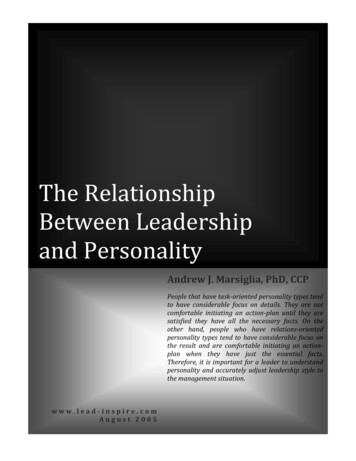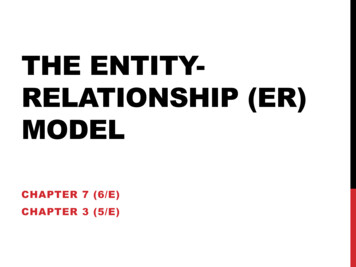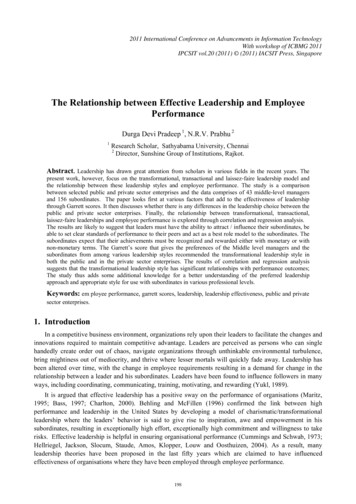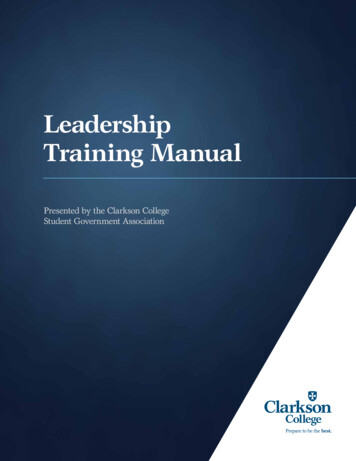
Transcription
The RelationshipBetween Leadershipand PersonalityAndrew J. Marsiglia, PhD, CCPPeople that have task-oriented personality types tendto have considerable focus on details. They are notcomfortable initiating an action-plan until they aresatisfied they have all the necessary facts. On theother hand, people who have relations-orientedpersonality types tend to have considerable focus onthe result and are comfortable initiating an actionplan when they have just the essential facts.Therefore, it is important for a leader to understandpersonality and accurately adjust leadership style tothe management situation.www.lead-inspire.comAugust 2005
The Relationship between leadership and PersonalityAndrew J. Marsiglia, PhD, CCPAugust 2005People who have task-oriented personality types tend to have considerable focus on details.They are not comfortable initiating an action-plan until they are satisfied they have all thenecessary facts. On the other hand, people who have relations-oriented personality types tend tohave considerable focus on the result and are comfortable initiating an action-plan when theyhave just the essential facts (Blake & Mouton, 1982). Therefore, it is important for a leader tounderstand personality and accurately adjust leadership style to the management situation. Bass(1990) states,Personality theorists tended to regard leadership as a one-way effect: Leaders possessqualities that differentiate them from followers. But these theorists did not acknowledgethe extent to which leaders and followers have interactive effects by determining whichqualities of followers are of consequence in a situation. (p. 12)Personality predicted leadership emergence across a variety of people and settings. Lord (1986)states, “In short, personality traits are associated with leadership emergence to a higher degreeand more consistently than popular literature indicates” (p. 407). In addition, Barrick and Mount(1993) have found a significant association between personality and job performance.The combination of leadership style and personality type appears to meld into apsychological combination that produces the ethos of a leader. “Leaders are not just identified bytheir leadership styles, but also by their personalities, their awareness of themselves and others,and their appreciation of diversity, flexibility, and paradox” (Handbury, 2001, p. 11). In addition,McGregor (1960) states, “It is quite unlikely that there is a single basic pattern of abilities andpersonality trait characteristics of all leaders. The personality characteristics of the leader are notunimportant, but those which are essential differ considerably depending on the circumstances” Relationship Between Leadership and Personality1
(p. 180). Therefore, it may indeed, make a difference in ascertaining personality type in order todetermine the correct job match between an employee and his or her colleagues.Historical OverviewThe ancient era of leadership theory, from about 2300 B.C. to 1A.D., was characterized bythe idea of leaders being great men who were sources of authority and justice. Leaders wereexpected to behave in a manner imagined by their society and culture as appropriate for aparticular role such as a king, chief, prince, or prophet. They were considered to be heroic,inspirational and endowed with special leadership power that enabled them to capture theirfollower’s imagination (Bass, 1990). So powerful was this effect that when Woods (1913)examined the evolution of leadership in 14 countries over a 14-century period, he concluded thatthe great-man leaders made their nation and shaped it in accordance with their abilities.The classical era of leadership range from 1 A.D. to 1869 and the neoclassical era range from1870 to 1939 encompassing a substantial portion of the industrial era. During the Industrial era,organization theories were based on social, demographic, and economic issues that related to arelatively stable command-and-control, production-oriented environment. These theoriesprovided a foundation for establishing procedures for managing personnel and equipment as wellas creation of formal organization structures to insure production stability. This produced anenvironment characterized by large organizations that were regionally located and predominantlyemployed local male workers. These workers composed a homogeneous group that typically hadlittle or no formal education, conducted their life activities within a few miles of their work site,and had personal familiarity with most of their colleagues (Hatch, 1997; Jacques, 1996; Shafritz& Ott, 2001). However, as organizations developed interests outside of their regional areas,especially interests in foreign countries, demographic homogeneity gave way to diversity of Relationship Between Leadership and Personality2
personnel that included different ethnic, racial, and gender groups. In addition, increasedglobalization and cultural diversity led to greater information generation and dissemination. Theresult has been an increasingly open environment, heterogeneous demographics and greaterknowledge of non-local affairs, all of which has increased the feeling of uncertainty (Handy,1996).The industrial era of organization theory is characterized by its focus on stability,authoritarian management, and formal structure and appears to have spawned leadership theorieswhere leadership was a product of the emerging effect of leader and follower interaction,differentiated roles, and compliance-induction. In fact, the compliance-induction theory appearsmost prevalent during this period because its authoritarian, directive approach enabled leaders toaccomplish the most work with the least friction and greatest cooperation .The American Civil War from 1861 to 1865 had a profound effect on American industry andgovernment by virtue of the fact that war production in the northern states stimulatedmanufacturing activity to high production levels. The southern states, however, sufferedconsiderable damage to manufacturing infrastructure and civil government. The positiveconsequence, however, is that after southern industry was rebuilt it became a major contributorto the country’s modern industrial resource (Hummel, 1996).In the post-Civil War period of 1869 to the World War II period beginning in 1940, theUnites States significantly increased its influence as a world political power and manufacturingproducer (Hummel, 1996; Jacques, 1996). This environment appears to have created a newleadership focus that included greater reliance on trait theory where ideal leaders wereconsidered to have the greatest number of personality traits and attributes (Bass, 1990). Throughthe end of the nineteenth century up to mid-twentieth century leadership theorists appeared to Relationship Between Leadership and Personality3
focus less on compliance-induction theory and more on the concept of leadership as a product ofgroup processes and as a form of persuasion where there is a reciprocal relationship betweenleaders and followers. This approach is espoused by Cowley (1928), who posited that a leader asa person who moved followers toward a mutual objective. In addition, Tead (1935) states that aleader should influence people to cooperate to attain a desired common goal.There appears to be no single universal definition of leadership but rather definitions relate tovarious leadership perspectives such as personal traits, power-influence, behavioral aspects, orsituational environment. Hogan (1994) defines leadership, “Leadership involves persuadingother people to set aside for a period of time their individual concerns and to pursue a commongoal that is important for the responsibilities and welfare of a group” (p. 494). Yukl (1989)posits, “Leadership includes influencing task objectives and strategies, influencing commitmentand compliance in task behavior to achieve these objectives, influencing group maintenance andidentification, and influencing the culture of an organization” (p. 253).In an effort to develop a comprehensive definition of leadership, Bowers and Seashoreformulated four basic dimensions of leadership:1. Support: Behavior that enhances someone else’s feeling of personal worth andimportance.2. Interaction Facilitation: Behavior that encourages members of the group to develop close,mutually satisfying relationships.3. Goal Emphasis: Behavior that stimulates an enthusiasm for meeting the group’s goal orachieving excellent performance. Relationship Between Leadership and Personality4
4. Work Facilitation: Behavior that helps achieves goal attainment through activities such asscheduling, planning, and providing resources such as tools, materials, and technicalknowledge.Leadership is frequently defined in terms of transactional and transformational dimensions.The paradigm of transactional-transformational leadership has universal applicability across allcontinents and cultures. In terms of universality, Bass (1990, p. 137) declares, “Transformationalleadership tends to be more effective and satisfying than contingent rewarding, contingentrewarding is more effective and satisfying than managing by exception, and managing byexception is more effective and satisfying than laissez-faire leadership.”During the 1980’s theorists began to recognize the importance of personal and nationalcultural influence on leadership paradigms. In the global economy of the 21st century, occidentalmanagement theories and techniques in some form will be adapted to countries around the world.In order to be effective, however, the theories must incorporate cultural variations and will becombined with oriental management theories thereby producing management techniques thathave near-universal applicability (Hofstede, 1984). “Feedback from subordinates should be partof an organization’s leadership performance assessment program. Such feedback, along withself-assessment, provides useful information for leadership development purposes and may helpin closing the gap between actual and desired performance” (Kolb, 1995, p. 244).Current FindingsLeader EffectivenessLeader effectiveness is dependent on the leadership problem-situation, team-dynamics,organization culture, and strategy. Consequently, the leader must employ a multiple level of Relationship Between Leadership and Personality5
leadership skills in order to be effective (Yammarino, 2000). Hogan (1994, p. 497) submits thatthere are five categories that may be used to evaluate leader effectiveness:1. Actual performance of the organization unit or team2. Ratings by peers, subordinates, and superiors3. Results of interviews, simulations, or assessment centers4. Self-ratings5. Perceptions of people whose careers are in jeopardy.Team dynamics and processes generally provide rapid and measurable results fordetermining leader effectiveness. Team processes have a reciprocal relationship in whichleadership processes and team processes influence each other as team members become moreexperienced in their job related skills or in other words, the team members become gain job-skillmaturity. Zaccaro (2001) states, “We have also suggested that as teams become moreexperienced and achieve a significant level of expertise, other members take over more of theleadership functions while designated leaders retain their boundary spanning responsibilities” (p.477). In addition, leader effectiveness may be increased when the leader takes a relationship orpartnership approach. The leader-follower relationship is reciprocal because as the leaderinfluences the subordinate to become more effective and as this effectiveness increases, thesubordinate requires less direct leader intervention (Hamilton & Schriesheim, 2001; Higgs &Roland, 2001).When a leader uses a partnership approach with his or her team, leadership assumesfunctional characteristics. A functional perspective of leadership focuses on the essentialfunctions of a work group, and the ancillary organizations supporting the work group.Leadership functions should be functionally equivalent to those of the work group. In addition, Relationship Between Leadership and Personality6
functional leadership recognizes the skill maturity of the work group. At low levels of jobmaturity, employees performing new tasks require encouragement and support. As employeesgain job maturity, they require less direct leader intervention (Behling & Rauch, 1985).In some situations, indirect leadership may increase effectiveness. Leaders often directlyapply their problem solving skills, knowledge, solution formulating skills, and social judgment toa leadership situation. Effective leadership may be achieved by using more of an indirectapproach. Mumford (2000, p. 167), states, “. . . leadership may sometimes be a rather indirectphenomenon where influence is exercised through cognition and performance as well as throughinterpersonal interaction.”In a study for the U.S. Army, Connelly (2000) determined criteria for leader effectivenessusing both military and civilian subjects. Connelly (2000, p. 77) declares, “The Army studyemphasizes the importance of creative thinking, complex problem-solving skills, and socialjudgment skills, while the civilian study serves as a reminder that other leader attributes, such aspersonality and motivation, are critical to a leader’s success.”Hater and Bass (1988) conducted a study of highly educated workers and discovered that atransformational leadership approach, displaying various amounts of participative decisionmaking, generated high motivation and work effectiveness. Transaction leadership on the otherhand, did not produce high motivation from workers who expected personal enrichment fromtheir job-related activities. Transformational leadership is frequently considered to be mosteffective at higher levels within an organization’s hierarchy. A transformational leadership style,however, may be more effective at lower management levels. Effective leaders will not relysolely on a transactional leadership style but will move between transformational and Relationship Between Leadership and Personality7
transactional styles as required by the situation and subordinate characteristics (Howell &Avolio, 1993; Lowe & Galen, 1996).It is difficult to predict leader effectiveness by using only single measurement criteria. Amulti-criteria measurement system has greater probability of predicting leader effectiveness.Hogan (1994) states, “In our judgment, the best way to forecast leadership is to use acombination of cognitive ability, personality, simulation, role play, and multi-rater assessmentinstruments and techniques” (p. 497). It appears that personality measures are efficacious inpredicting effective leadership. Personality typing using validated instruments such as the MyersBriggs Type Indicator may improve leader-subordinate communication and increase leadereffectiveness (Witt, 2000). In addition, leader traits and behavior influence leader success acrossa variety of situations. Using the 16 Personality Factor Questionnaire, Hartman (1999) found thatpersonalities high in “Factor A, Warmth,” were more effective in their leadership roles.In research conducted by Day and Stogdill (1972) it was determined that that there was noappreciable gender difference in leader effectiveness. Male and female leaders in parallelleadership positions exhibited similar patterns of leader behavior and were regarded by theirsuperiors as being similar in leader effectiveness.Job SatisfactionJob satisfaction depends on a plethora of elements. Measuring only one or two elements suchas leadership style, personality, or least preferred co-worker may not produce a full explanationof the most effective leadership style to use in a particular situation. Analysis of subordinate’scultural, career progress perceptions, relationship between job characteristics and attitude, andnon-job related characteristics in order to produce a more comprehensive assessment of job Relationship Between Leadership and Personality8
satisfaction (Chan & Drasgow, 2001; Glick, Jenkins Jr., & Gupta, 1986; Scarpello & Campbell,1983).In a study of the relationship of job satisfaction to job performance Petty (1984) proved thereis a positive relationship to individual job satisfaction to individual job performance. Popularbooks such as Theory X (Ouchi, 1981), In Search of Excellence (Peters & Waterman, 1984), andThe One Minute Manager (Blanchard & Johnson, 1985) suggest a direct relationship betweenjob satisfaction and performance. It seems logical, therefore, to conclude that Blanchard’s(2001b) Situational Leadership II theory will be applicable to the study of leadership style andproject manager job tenure.In expressing concern that the benefits of the social scientific study of leadership are notbeing applied enough in practical situations, Hogan (1994) states, “ what we know aboutleadership seems to have little impact on the people who actually make decisions aboutleadership” (p. 494). This may provide a partial explanation of why the Managerial Grid andSituational Leadership II form the basis of popular commercial leadership training programs.These programs appear to be intuitively appealing to non-academicians. That is, non-leadershipresearchers immediately perceive or mentally understand, without intermediate explanation, thepractical application of leadership concepts.Using monozygotic twins reared apart, Arvey (1989) studied the genetic predispositions of aperson gravitating toward staying in a particular type of job environment and the person’sconcept of job satisfaction as measures by the Minnesota Job Satisfaction Questionnaire. Resultsof the study indicated that there are significant inherited traits that cause people to seek andremain in certain types of jobs. Therefore, it appears important for organizations to accurately Relationship Between Leadership and Personality9
define the personal characteristics required for a person to be successful in a particular leadershiprole and to test candidates to insure they will be a proper fit for the job.Personality and LeadershipCertain personality traits are positively related to leader effectiveness and team performance.These personality traits include surgency, emotional stability, conscientiousness, andagreeableness. Even though there are no universal personality traits that are predictors of leadereffectiveness in all situations, some situations and organization cultures require specificpersonality traits and leadership styles relative to the follower’s expectations of a leader (Hoganet al., 1994). “Personality traits, such as agreeableness, conscientiousness, extroversion,openness, neuroticism, and self-monitoring influence implicit leadership theories. Specifically,individuals characterize a leader similar to self as ideal” (Keller, 1999).Hollenbeck (2000) developed an integrated theory of person-organization fit in which thestructure of an organization is compared to the personality traits of the organization’s people.Typically, organizations develop a functional structure that enables it to successfully integratewith its external environment. The functional structure characteristics create unique internalenvironment conditions that require organization members of particular personality traits in orderto attain organization efficiency. In addition, Hollenbeck (2000) suggested that successfulorganizations employ people that have personality traits that enable the workers to fit well intoboth the organization’s internal and external environments.Senior executives often select people for a leadership role solely based on the criteria of thecandidate’s operational efficiency or experience. Sorcher (2002) suggests that the selectionshould be made on a broad range of soft leadership criteria including personal integrity, culturalbackground, and personality. Hogan (1994) states, “In our judgment, the best way to forecast Relationship Between Leadership and Personality10
leadership is to use a combination of cognitive ability, personality, simulation, role play, andmulti-rater assessment instruments and techniques” (p. 497). In addition, personality measuresare efficacious in predicting effective leadership.Proactive personality was positively associated with both self-reported objective successcriteria of salary and promotions as well as the subjective success-criteria of career satisfaction(Seibert, 1999). In a study of six hundred fifty-two employees composing 51 work teams it wasdetermined that relationships of team member’s ability, personality and social cohesioncontributed positively to team viability and team performance. “With respect to compositionvariables, teams higher in general mental ability, conscientiousness, agreeableness, extroversion,and emotional stability received higher supervisor ratings for team performance” (Barrick, 1998,p. 377). In addition, the three personality characteristics of autonomy, control, and motivationorientation influence performance and achievement through achievement goal patterns, goallevel, and mental focus. “Research suggests that global personality traits can help researchers tounderstand and predict the motivational strategies that people use while working toward goals inachievement settings” (Lee, 2003, p. 256).A U.S. Army study examined criteria for leader effectiveness using both military and civiliansubjects and discovered the importance of personality and leadership. Connelly (2000, p. 77)declares, “The Army study emphasizes the importance of creative thinking, complex problemsolving skills, and social judgment skills, while the civilian study serves as a reminder that otherleader attributes, such as personality and motivation, are critical to a leader’s success.” Militaryand civilian senior executives often select people for a leadership role solely based on the criteriaof the candidate’s operational efficiency or experience. Sorcher (2002) suggests that the selection Relationship Between Leadership and Personality11
should be made on a broad range of soft leadership criteria including personal integrity, culturalbackground, and personality.Prior research has shown that personality characteristics can be accurately assessed using ofthe Meyers-Briggs Type Indicator (Witt, 2000; Young, 2001), DiSC , (Morgan, 2000),Multidimensional Personality Questionnaire (George, 1990), and the Five Factor Model(Barrick, Mount, & Judge, 2001; Larson et al., 2002). Judge (2002, p. 1) declared, “Overall, thefive-factor model had a multiple correlation of .48 with leadership, indicating strong support forthe leader trait perspective when traits are organized according to the five-factor model”. In fact,considerable personality-leadership effectiveness research has been conducted using the Big FivePersonality Model or Five Factor Model (hereafter referred to as FFM). Barrick and Mount(2001) summarized the results of 15 meta-analytic studies, conducted over the prior 50 years thatfocused on the relationship of FFM personality characteristics to prediction of job performance.Results, summarized in Table 1, indicated that there is a positive relationship of FFM dimensionsto job performance. In particular, conscientiousness and emotional stability were positivelycorrelated to job performance in all jobs while the other FFM dimensions only had positivecorrelation to specific occupations. Salgado (2003) reached a similar conclusion in a study ofWestern European firms. Relationship Between Leadership and Personality12
Table 1:Correlation Between the FFM Dimensions and Job Performance.FFM DimensionCorrelation to Job PerformanceConscientiousnessPositive correlation in all jobsEmotional stabilityPositive correlation in all jobsExtraversionCorrelation for specific occupations onlyAgreeablenessCorrelation for specific occupations onlyOpenness to experienceNot relevant to most jobsLarsen (2002) declared, “For understanding an individual’s total personality, it is absolutelynecessary to know something about the kinds and intensity of his interests” (p.217). In fact, fordecades researchers have suggested there is a direct link between personality and vocationalinterests. In an effort to determine correlation between personality and vocational interests,studies were conducted using Holland’s Big Six domains of vocational interest and the Big Fivemodel of personality traits (Barrick et al., 2003; Furnham, 2001; Larson et al., 2002). Results ofthe study showed a clear link between personality type and vocational interests. Larson declared,“Of the 30 correlations, five appeared to be substantial for both men and women and acrossinterest measures. They are Artistic-Openness (r .48), Enterprising-Extraversion (r .41),Social-Extraversion (r .31), Investigative-Openness (r .28), and Social-Agreeableness (r .19)” (Larson, 2002, p. 217). Barrick’s (2003) research yielded similar results with EnterprisingExtraversion (r .41) and Experience-Openness (r .39). Overall conclusions of these studies,however, indicate that while Big Five personality traits are directly related to the Big Sixvocational interests, they are not substitutes for each other. Relationship Between Leadership and Personality13
Five Factor Model of PersonalityThe Five Factor Model of Personality consists of five primary personality traits: Neuroticism,Extraversion, Openness to Experience, and Agreeableness. Although this model cannot accountfor all aspects of human personality, it is relevant to gaining a macro understanding of a person’spersonality (McCrae & John, 1992). Even though the Big Five is not a complete theory ofpersonality, it serves as a practical framework to bring cohesion to the myriad of personalitytheories (Digman, 1997).Ployhart (2001) conducted a study to determine if the Five Factor Model of Personality(hereafter FFM) could predict transformational ratings of transformational leadership. Results ofthe study showed a strong relationship between personality and transformational leadership.Furthermore, research conducted by Judge and Bono (2000) showed direct relationship betweenthe Five Factor Model and transformational leadership. Extraversion and agreeablenesspositively predicted transformational leadership. Openness and Experience were positivelycorrelated to transformational leadership. Neuroticism and Conscientiousness were unrelated totransformational leadership. Bono states, “. . . organizations might benefit from selecting leaderson the basis of certain personality traits” (2000, p. 763).Even though Block (1995) questioned the validity the Five Factor personality model hedeclared, “. . .the contemporary Big Five represents a clarifying and advancing framework thatcan provide needed integration for the archaic field of personality assessment” (p. 207). Smith(2001) investigated criticism that the Big Five model was an inadequate tool for personnelselection. Research, however, showed that the Big Five was an accurate predictor of performanceand that personality testing is an effective tool in personnel selection methods (Salgado, 2003;Tett, Jackson, & Rothstein, 1991). Relationship Between Leadership and Personality14
The Big Five personality dimensions of Consciousness and Extraversion are significantlyrelated to job performance and are a useful tool for examining the relationship betweenpersonality and job performance criteria (Barrick, 1993; Hurtz & Donovan, 2000). Barrick andMount (1991) performed a meta-analysis to determine the correlation of the Big Five personalitydimensions to three job performance criteria: job proficiency, training proficiency, and personneldata. The meta-analysis showed a direct correlation with all performance criteria. Althoughpersonality assessment has utility for predicting job performance, researchers should becognizant that their analysis should address the relations between the personality and contextualperformance (Bryman & Stephens, 1996; Hurtz & Donovan, 2000).Hollenbeck (2000) developed an integrated theory of person-organization fit in which thestructure of an organization is compared to the personality traits of the organization’s people.Typically, organizations develop a functional structure that enables it to successfully integratewith its external environment. The functional structure characteristics create unique internalenvironment conditions that require organization members of particular personality traits in orderto attain organization efficiency. The five factor model of personality has proven to be effectiveto derive predictions of person-organization fit. In addition, Hollenbeck (2000) suggested thatsuccessful organizations employ people that have personality traits that enable the workers to fitwell into both the organization’s internal and external environments.The research with the FFM clearly shows the efficacy of using a well-structured, validatedmethod to assess personality characteristics. Using FFM methods, however, to determine majorpersonality characteristics is a more complex process than the self-administered DiSC methodproposed for this research project. The two methods are closely related as shown in the brieftaxonomy of Table 2. Relationship Between Leadership and Personality15
Table 2Comparison of the Five Factor Model and DiSC Personality Dimensions.Five Factor DimensionsDiSC DimensionsExtraversionDominanceAgreeableness scientiousnessSteadinessEmotional stabilityThe FFM dimension of Extroversion is a characteristic of having keen interest in otherpeople, external events, and venturing forth confidently into the unknown while the DiSC dimension of Dominance is characterized by a person that accepts challenges and is comfortablewith ambiguity. Agreeableness measures how compatible people are with other people. Open-toExperience refers to how willing peop
Relationship Between Leadership and Personality 1 The Relationship between leadership and Personality Andrew J. Marsiglia, PhD, CCP August 2005 People who have task-oriented personality types tend to have considerable focus on details. They are not comfortable initiating an action-plan un










